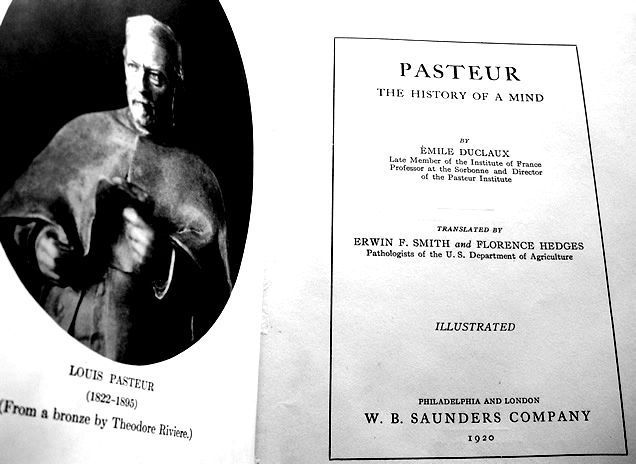7.34 History of a Mind
Pasteur
|
Pasteur - The History of a Mind,
a perspective "Pasteur: The History of a Mind" was
written by Emile Duclaux (1840-1904) and published in France one year after
Pasteur's death in 1895. Emile Duclaux followed the teachings of
Pasteur, entered his laboratory as his assistant, was later his collaborator
and actively participated in the founding of the Pasteur Institute. As
his readers we are indebted to him for achieving the difficult task of giving
posterity the most accurate genesis of Pasteur's discoveries.
Pasteur's rare gift was his vision of the world,
which he transformed by demolishing dogmas, stamping out erroneous views and
fiercely imposing his own insightful ideas. At least the reader of
"Pasteur - The History of a Mind" can grasp Pasteur's intuitive
imagination and extraordinary skill for experimentation. The reader can
further apprehend the genius in Pasteur by evaluating the colossal
advancement in biological knowledge resulting from his studies on crystals,
lactic and alcoholic fermentation, spontaneous generations, wines and
vinegars, diseases of silkworms, manufacture of beer, etiology of microbial
diseases, and vaccines. In the early years of his life as chemist, while
doing research on the left-right molecular asymmetry and its mode of action
on polarized light, Pasteur was introduced to the realm of life. A
living fermentative organism became a "laboratory of dissymmetrical
forces" and, as Pasteur soon discovered, could differentiate between the
left- and right-handed activities of a molecule, and utilize one form without
touching the other. Naturally the young savant approached the question
of fermentations and later spontaneous generations. At the time Pasteur initiated his studies on
fermentations there was quite a confusion of ideas and a multitude of
arguments, particularly it was largely accepted that yeast was not involved
in fermentation. Carried by the knowledge gained during the course of
his studies on asymmetry, Pasteur immediately considered fermentation as
"a vital act". A series of brilliant experiments followed
leading Pasteur to discover the reproduction of "ferments", the
effect of acidity on fermentation, the use of antiseptics to separate
ferments, the products of fermentation and finally the division between
aerobic and anaerobic life. Now Pasteur could no longer believe in
spontaneous generations as it denied the notion of specificity he had just
introduced with his studies on fermentation. Before Pasteur, the debate on spontaneous
generations was mislead by experiments lacking reproducibility. Pasteur
who had ingeniously defined a clear medium to study his ferments was ready to
enter the arena. Experiments confirmed his previous belief and the
partisans of spontaneous generations were given correct reasons for their
experimental failure. Thereafter heated debates occurred in front of
committees named by the Academy of Science and, despite the fact that some
experimental results were given improper explanations, the recognition of the
"germ theory" prevailed. From this resulted safe conditions
in conducting experiments by the introduction of autoclaves as well as
techniques such as sterilization by flaming. Pasteur's discovery of the bacterial action in
the production of wines and vinegars had also practical consequences.
Industrial methods in the production of wines and vinegar were greatly
improved and the concept of pasteurization, the protection against microbes
by the action of heat, then introduced. What remains distinctive is
Pasteur's classical demonstration of the action of oxygen on wine. In 1865, Pasteur's destiny shifted towards a new
course when he accepted to study the disease of silkworms to which he devoted
six years. He discovered that diseases may result from the development
of a microbe in healthy tissues of its host. Pasteur's orientation
towards pathology would ultimately lead him to make a connection between
contagion and heredity. By studying the contagious diseases of the
silkworms he addressed for the first time the question of "receptivity
to germs". He was on the path leading towards immortal fame. The consecutive study -the manufacture of beers-
was started by Pasteur with the motivation of raising the quality of French
beers to German standards. Ultimately Pasteur's book on brewing will
reflect the fact that his mind was at that time preoccupied by questions more
crucial to him than the problems of the French brewers. The specificity
of his germ theory had been attacked by the partisans of the transformation
of microscopic species. The notion of spontaneous generation of yeast
was resurfacing. It is one more time by experimentation that Pasteur
demonstrated that a microscopic species does not transform into another
thereby establishing the specificity of microbial diseases. Furthermore
he described the adaptation of microscopic species to aerobic or anaerobic conditions
giving birth to the physiological theory of fermentation. Pasteur had now studied his microbes for twenty
years. The general current of ideas about diseases did not support the
germ theory, and diseases were generally considered the results of
"forces of the physico-chemical order". Anthrax, despite
Davaine's pioneer work and Koch's brilliant demonstration of the role of the
spore in the etiology of this disease, was still not regarded as a bacterial
disease. In his final studies, Pasteur developed vaccines
for chicken cholera, anthrax and rabies. As he gained public confidence
his popularity increased thereby allowing the creation of the Pasteur
Institute. By studying the transmission of bacterial diseases he gave a meaning to the notions of attenuation and virulence. He apprehended the
concept of natural immunity and finally foresaw the cellular theory of
immunity later demonstrated by Metchnikoff and his discovery of the white
corpuscles of the blood. Pasteur was a savant, a man of the
laboratory. His life echoed Alfred Lord Tennyson's poem
"Ulysses" [1842] in his final verse: "To strive, to seek, to find, and not to
yield." |
|
Suggested Reading: Scientific papers by Louis
Pasteur, in The Harvard Classics, Volume 38, Part 7 On the antiseptic principle of the
practice of surgery by Joseph Lister, in The Harvard Classics, Volume
38, Part 6 The
Pasteur Institute by François Jacob, 1998, at Nobelprize.org |



